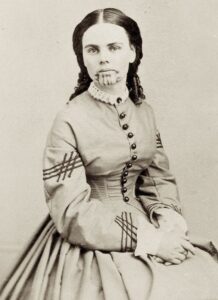
FREE Short Story: The Seamstress
For your FREE short story, type your email address below.
You'll get the short story, plus fun facts about the Wild West, and news about upcoming stories.

For your FREE short story, type your email address below.
You'll get the short story, plus fun facts about the Wild West, and news about upcoming stories.
I was treated this Valentine’s Day to a wonderful brunch by my dear Valenti ne, who cooked up cheesy scrambled eggs with sour cream and bacon on toasted bagels, and roasted tomatoes, peppers and mushrooms on the side. It was heavenly.
ne, who cooked up cheesy scrambled eggs with sour cream and bacon on toasted bagels, and roasted tomatoes, peppers and mushrooms on the side. It was heavenly.
But how about a tale from the Wild West of a more bittersweet Valentine’s Day? It is the story of Olive Oatman, an American who lived among the Mohave tribe for five years.
Olive Ann Oatman was born in Illinois in 1837 to a family of Mormons. In 1851 the family, together with a group of about fifty, decided to seek a new home in California. They travelled across the Great American Desert by covered wagon. While crossing New Mexico, they were warned that the Native Americans living in the area were hostile to outsiders. The group decided to stay in the settlement they’d reached, but Olive’s family wanted to continue. The family—father, mother and seven children ranging in age from seventeen to one—made it into Arizona, where they were attacked by a group later described as Apaches, although this has never been confirmed. The parents and all but three of the children were killed. Lorenzo, the fifteen-year-old son, was left for dead. Olive, fourteen, and Mary Ann, seven, were taken captive.
The two girls were force-marched across the desert and nearly starved to death. They lived a precarious nomadic life with the group of Apaches until a year later, when they were sold to some Mohaves. This tribe took them to eastern California, along the Colorado River, where they led a more settled life. They were treated as slaves, but managed to learn the Mohave language, and were befriended by several in the tribe, including the daughter of the chief, who took pity on them.
Unfortunately, conditions were difficult for the tribe and after several years, little Mary Ann died, probably of starvation. The tribe wanted to cremate the body, as was their custom, but Olive begged them to let her bury her sister in the Christian way.
After four more years, rumors of a captive white woman made their way to Fort Yuma in south California, and the residing commander used his Native American contacts to make enquiries. A delegation was sent to the Mohave tribe, demanding that Olive return with them. The tribe debated handing her over, but were eventually convinced by the threat that the military would be sent in to destroy the tribe if they didn’t comply. Olive herself seemed to have been in two minds. While she was overjoyed to be released and taken back to the civilization she’d known as a child, she agonized over leaving the grave of her sister. In her own words, “Gladly would I, if it had been in my power, have gathered the few moldering remains of that loved and cherished form, and borne them away to a resting-place on some shaded retreat in the soil of my own countrymen. I went to the grave of Mary Ann, and took a last look of the little mound marking the resting-place of my sister who had come with me to that lonely exile; and now I felt what it was to know she could not go with me from it.”[i]
The day she was taken from the Mohave tribe back to Fort Yuma was February 14, 1856. She was overjoyed to be free again, but adjustment back into white culture was a struggle. After five years of not hearing or reading English, she found it awkward to speak and write at first. Her chin had been tattooed by the tribe—blue vertical stripes. She came to be known as the “veiled lady” in her attempts to disguise this disfigurement.
Her greatest joy was finding out that her older brother, Lorenzo, had survived. It was he who had discovered word of her in eastern California, and had spent years trying to rescue her and Mary Ann. Her memoirs were published in Captivity of the Oatman Girls, co-authored with Rev. R. Stratton, in 1857. The Rev. Stratton took Olive on a tour of the western United States, where she spoke about her experiences to crowds of eager listeners. She became famous, and the money raised from her tours enabled Lorenzo to attend college.
She eventually married John Fairchild, a businessman, and the two settled in Texas, where she helped out in the local orphanage. The couple adopted a little girl and named her Mary Elizabeth, after Olive’s sister and John’s mother. She lived to the age of sixty-five, but she would never have forgotten that poignant Valentine’s Day, when she, as a nineteen-year-old, experienced such exhilaration of freedom and such despair of loss.

[i] Captivity of the Oatman Girls, Being an Interesting Narrative of Life Among the Apache and Mohave Indians, by R.B. Stratton, 1857. Public Domain, courtesy of the Gutenberg Project, 2017, www.pgdp.net.